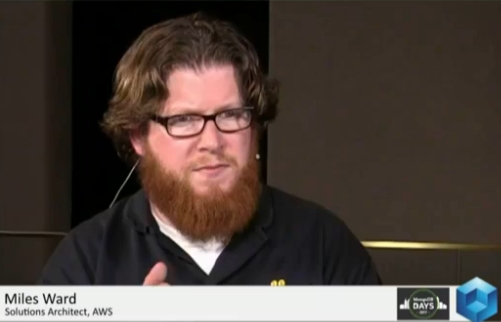 NEWS
NEWS
 NEWS
NEWS
 NEWS
NEWS
![]() Dave Vellante and Jeff Kelly attended the Mongo DB Days Event in New York, broadcasting live a series of interviews as part of the flagship program, theCUBE. They managed to sit down with Miles Ward, Solutions Architect with AWS, and talk about the UX, business changes, industry trends and best practices.
Dave Vellante and Jeff Kelly attended the Mongo DB Days Event in New York, broadcasting live a series of interviews as part of the flagship program, theCUBE. They managed to sit down with Miles Ward, Solutions Architect with AWS, and talk about the UX, business changes, industry trends and best practices.
Dave Vellante kicked off the interview by asking Miles Ward why he chose to participate in this event. The answer? “Amazon Web Services listens to customers. We’re focused on insuring that the customers have the greatest experience and that they build the next generation network infrastructures that power their businesses,” and that is a belief, not a marketing advertising, said Ward.
“I sat in NASA facilities at JPL Pasadena while we powered the live streaming of the landing of the Mars Rover. If helping that kind of company take data from Mars and store it in S3 is not changing the world, I don’t know what is,” said Ward.
Miles Ward praised Mongo, saying that: “In this ecosystem of change, we’re watching a whole new set of technology tools that break the standards, that have altered the baseline of what you can squeeze – from a performance standpoint – out of hardware. MongoDB, as the leader in the NoSQL Open Source space, is doing things that other technologies are not able to do.”
For example, document stores speak the same language as applications. They interact using exactly the same data structures that your software and your websites use. As a developer that has to learn the Full Stack, you got to be great all the way across, from front-end to back-end. “Being able to interact with a data storage system that speaks to the application developers that’s actually storing data the way that applications use data is a game changer.”
AWS built a series of products that add value from a personal blog that costs one penny every nine months (cause that’s when the S3 charges round up to a penny), to giant businesses deploying millions of dollars of infrastructure. “We add value and differentiated benefit for businesses all across that continuum,” explained Ward.
Asked about his role with AWS, Miles Ward obliged: “My role as a Solutions Architect is trying to figure out how our tools work at that broad continuum. I go work with start-ups, with our partners and with very technical businesses, as well as with businesses that don’t want to be very technical, trying to get them to learn the best practices for extracting value form the cloud,” added Ward.
Next question from Vellante addressed the customers’ requirements: “How are the Enterprise customers’ requirements different, and how does that cause AWS to change the architecture and the way of response?” Ward responded that the Enterprises want to earn the same value the little start-ups have earned.
The Enterprises want business agility, lower time-to-market, lower operational costs and no capital cost, and they want it all to operate in the same constraint business environment. The Enterprise customers are taking their cues from younger, smaller businesses and start-ups, and making sure they get the same business value that they did.
“There is this undercurrent of change in the status-quo of what it means to be successful in IT. Businesses have decided that the infrastructure needs to be so nimble that it is now their own kind of business product. Building automation means building your business,” highlights Ward one of the trends in the business. “Infrastructure as code,” added Vellante. So, yes, Ward thinks that. We seem to be heading towards the idea that “My datacenter lives in my source control,” continued Ward.
In terms of adoption, this is what Ward has seen in the market: “Once you realize that the problems that the business has is not its ability to spend (the costs of the infrastructure it delivers) but its ability to move work through the pipeline more quickly, the ability to execute against business goals more nimbly, that’s when you start to invest in things that give you more flexibility.”
For his presentation at MongoDB Days, Miles Ward explained the reason behind AWS’ adoption of MongoDB: “MongoDB is one of the fastest growing NoSQL workloads on AWS due to its simplicity and scalability, and recent product additions by the AWS team have only improved those traits.”
THANK YOU